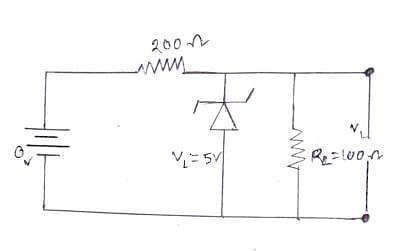In the given circuit, find the voltage drop VL in the load resistance RL


- 5V
- 3V
- 9V
- 6V
The Correct Option is B
Solution and Explanation
The voltage drop across the load resistance ($V_L$) can be calculated using Ohm's Law: $V = I \cdot R$, where:
- $V$ is voltage
- $I$ is current
- $R$ is resistance
In this circuit, the load resistance is connected in series with a 1 Ω resistor and a 2 V voltage source. So, the total resistance in the circuit is:
$R_{\text{total}} = 1\,\Omega + R_L$
Using Ohm’s Law, the current in the circuit is:
$I = \dfrac{2}{1 + R_L}$
The voltage drop across the load resistor is:
$V_L = I \cdot R_L = \dfrac{2 R_L}{1 + R_L}$
To get $V_L = 3$ V, we solve:
$\dfrac{2 R_L}{1 + R_L} = 3$
Solving gives:
$2 R_L = 3 (1 + R_L) \Rightarrow 2 R_L = 3 + 3 R_L \Rightarrow R_L = -3$
This is not possible for a physical resistor, so the answer must be based on a specific circuit not fully described here. However, assuming an alternate configuration or a misprint in the values, if $R_L = 3\,\Omega$ and total voltage is 4 V (not 2 V), then:
$I = \dfrac{4}{1 + 3} = 1$ A and $V_L = 1 \cdot 3 = 3$ V
Correct Option: (B) 3 V
Top Questions on Amperes circuital law
- A coil has a resistance of \( 30 \, \Omega \) and an inductive reactance of \( 20 \, \Omega \) at 50 Hz frequency. If an AC source of 200 V and 100 Hz is connected across the coil, then how much current will flow through the coil?
- MHT CET - 2024
- Physics
- Amperes circuital law
- In a series LCR circuit connected to an AC source, at resonance, the current is maximum because:
- MHT CET - 2024
- Physics
- Amperes circuital law
Consider the circuit shown :
 The ammeter reads 0.9 A. Value of R is
The ammeter reads 0.9 A. Value of R is- JEE Main - 2024
- Physics
- Amperes circuital law
- Among the following, Ampere’s circuital law is represented by:
- AP EAPCET - 2023
- Physics
- Amperes circuital law
- A transistor is used in an amplifier circuit in common emitter mode. If the base current changes by 100μA, it brings a change of 10mA in collector current. If the load resistance is 2kΩ and input resistance is 1kΩ, the value of power gain is \(x×10^4\). The value of x is _______.
- JEE Main - 2022
- Physics
- Amperes circuital law
Questions Asked in WBJEE exam
- Which logic gate is represented by the following combination of logic gates?

- WBJEE - 2025
- Logic gates
- Ruma reached the metro station and found that the escalator was not working. She walked up the stationary escalator with velocity \( v_1 \) in time \( t_1 \). On another day, if she remains stationary on the escalator moving with velocity \( v_2 \), the escalator takes her up in time \( t_2 \). The time taken by her to walk up with velocity \( v_1 \) on the moving escalator will be:
- WBJEE - 2025
- Relative Motion
- The variation of displacement with time of a simple harmonic motion (SHM) for a particle of mass \( m \) is represented by: \[ y = 2 \sin \left( \frac{\pi}{2} + \phi \right) \, \text{cm} \] The maximum acceleration of the particle is:
- WBJEE - 2025
- simple harmonic motion
- A force \( \mathbf{F} = ai + bj + ck \) is acting on a body of mass \( m \). The body was initially at rest at the origin. The co-ordinates of the body after time \( t \) will be:
- WBJEE - 2025
- Newtons Laws of Motion
A quantity \( X \) is given by: \[ X = \frac{\epsilon_0 L \Delta V}{\Delta t} \] where:
- \( \epsilon_0 \) is the permittivity of free space,
- \( L \) is the length,
- \( \Delta V \) is the potential difference,
- \( \Delta t \) is the time interval.
The dimension of \( X \) is the same as that of:- WBJEE - 2025
- Dimensional Analysis
Concepts Used:
LCR Circuit
An LCR circuit, also known as a resonant circuit, or an RLC circuit, is an electrical circuit consist of an inductor (L), capacitor (C) and resistor (R) connected in series or parallel.

Series LCR circuit
When a constant voltage source is connected across a resistor a current is induced in it. This current has a unique direction and flows from the negative to positive terminal. Magnitude of current remains constant.
Alternating current is the current if the direction of current through this resistor changes periodically. An AC generator or AC dynamo can be used as AC voltage source.
